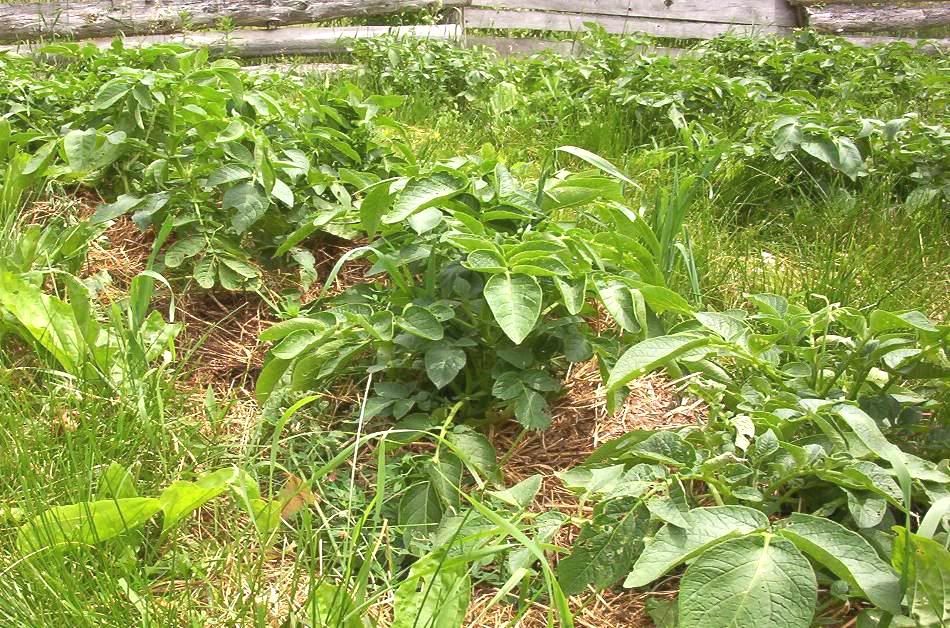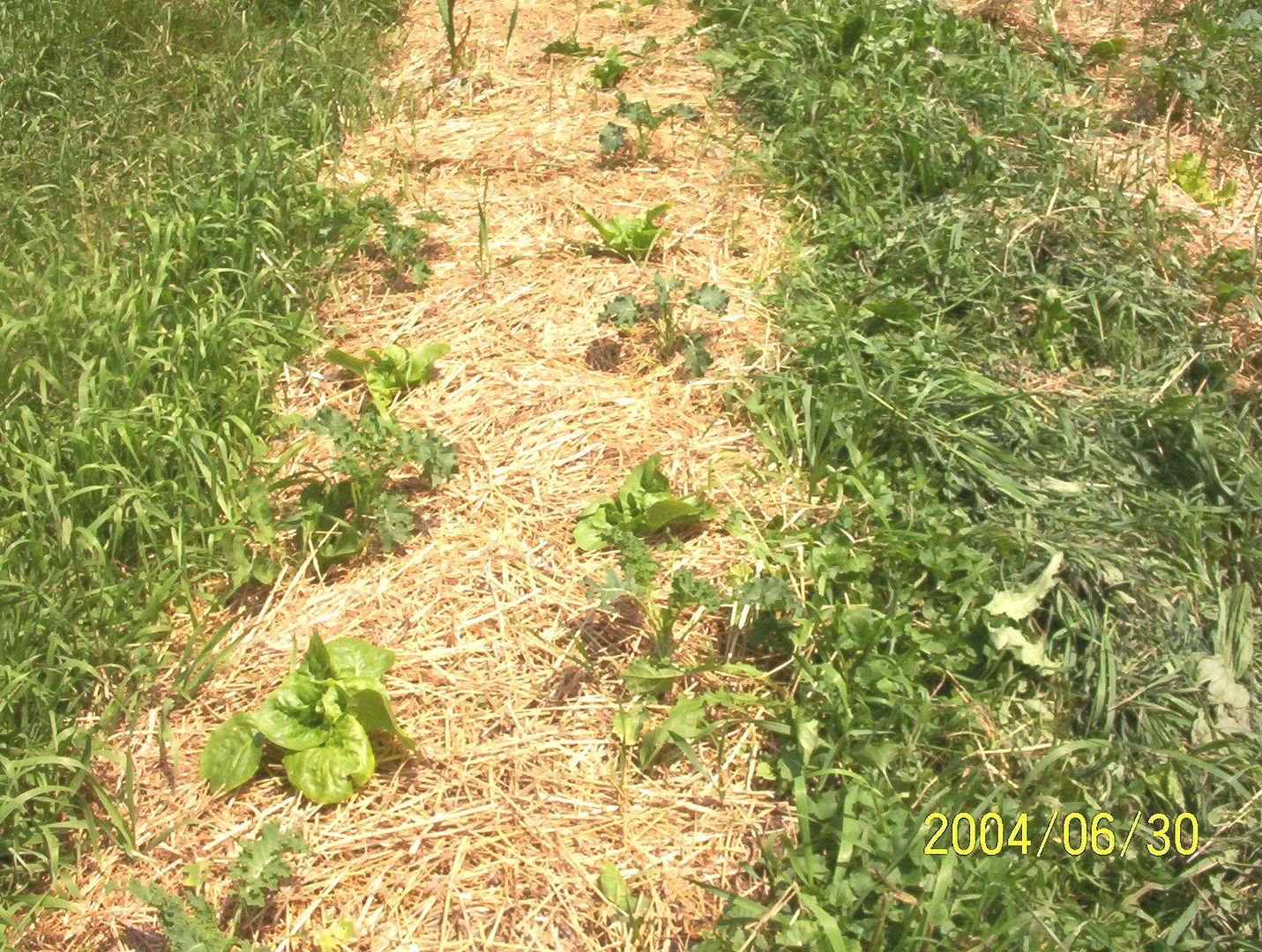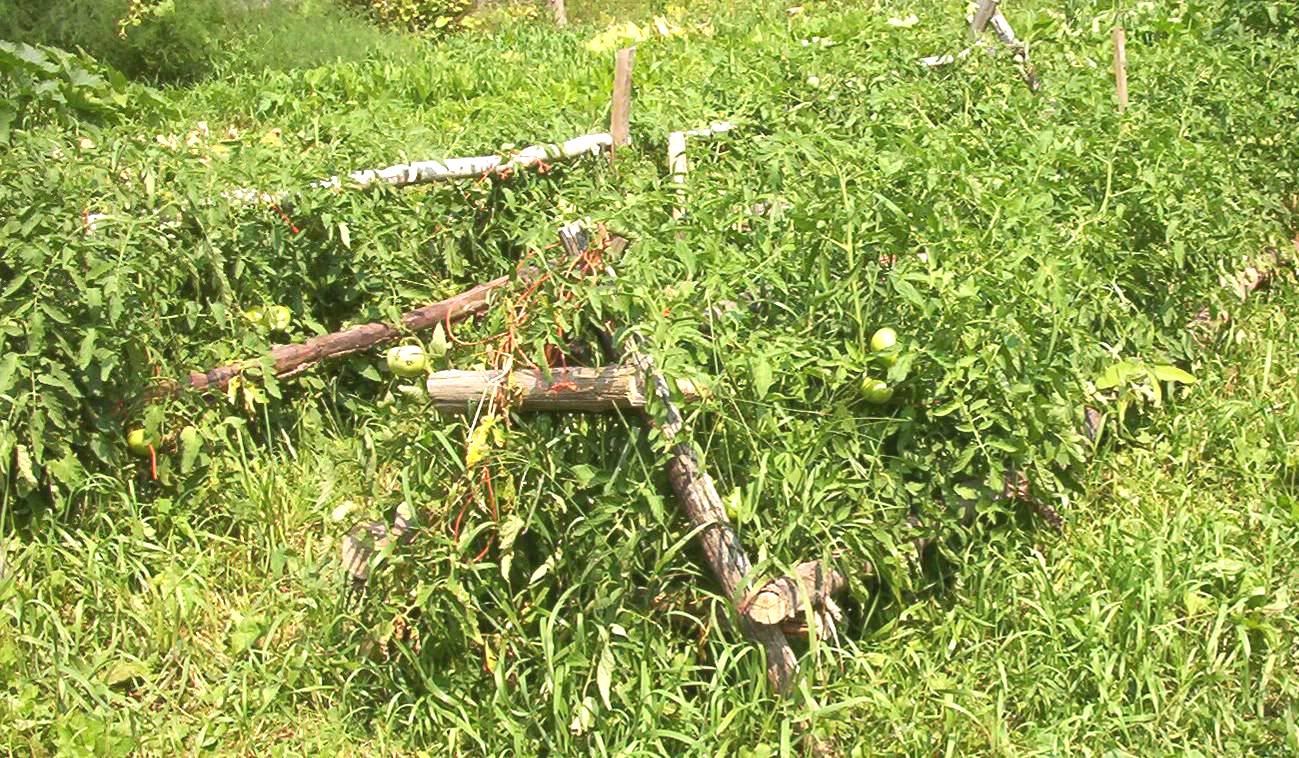She kindly agreed to an interview.
***

Potatoes growing in Hida Manns' home garden.
How did you come to study alternative agricultural practices?
My studies on alternative agriculture were stimulated from a desire to explain many experiences. When we built our own home in the country, I put in a garden and bought my first goats. Following years of reading on natural health for my family, I applied the same principles to my garden and goats. Instead of buying fertilizer, I read all the literature on gardening, including Ruth Stout’s method. The goats supplied ready composted hay that evolved into a garden system, that admittedly, was not productive in the first few years. I also read widely, including the work by de Bairacli Levi on raising animals without pharmaceuticals. From her principles, and my knowledge of food chemistry, I evolved my own intestinal parasite remedy for the goats.
Your talk at Eco Farm Day 2010 was about mycorrhizal fungal colonization. For those that may not know, what are they?
Mycorrhizal fungi are a symbiotic association of a fungus with the roots of a plant. It is believed that plants were able to evolve to live on land with the assistance of the fungus. The fungi produce a mycelium, which is like an enlarged root system, but at a smaller diameter scale (< color="#006600">According to the literature, how may mycorrhizal fungal colonization affect plant growth and soil (texture, moisture retention and so on)?
Due to the high variation in plant and soil response to mycorrhizal colonization, it is difficult to give specific benefits that apply to all. In general, mycorrhizal colonization re-allocate the carbon from photosynthesis to increase below ground carbon. Roots tend to be shorter and thicker, and plant growth likewise. It depends on how dependent the plant is on the mycorrhiza given all environmental conditions. The major finding from my research is that mycorrhizas are instrumental in preventing loss of soil structure, and therefore are very important in maintaining sustainability of the soil to hold water and nutrients. Many studies have found that photosynthesis increases with mycorrhizal plants, and the amount of soluble carbon in the soil is also increased. This may be the simple answer to increased nutrient uptake, plant growth, and soil aggregate changes.

Perennial 'weeds' growing between mulched beds in Manns' garden.
The title of your talk was provocatively named Farming with fungi instead of fertilizer. According to your research, how does fertilizer affect mycorrhizal colonization?
The title of the talk was meant to imply that the benefits of mycorrhizal colonization can result in net productivity similar to fertilizer addition. You have brought up an interesting point, where there is conflicting evidence on the interaction between fertilizer and fungi. Briefly, a small amount of NPK fertilizer will increase hyphae growth in nutrient limited conditions. However, it is commonly found that high NPK inhibits mycorrhizal colonization. In a small trial growing flax in small pots in the growth chamber, using soil from organic rotations following wheat, I found the addition of standard amounts of P and N did not increase colonization; mycorrhizal colonization was 10-20% lower.
I know that some people talk about adding mycorrhizal fungi when planting. What are your thoughts on garden inoculation?
My experience with mycorrhizal colonization suggests that creating supportive conditions maintains an adequate colonization. Specific practices would be mulching, keeping a winter cover crop, leaving roots in the soil over winter, or as I do, leave the alleys in perennial grasses (permanent host). The presence of a constant host (eg: a highly mycorrhizal plant like clover) is most important to maintain quick colonization. The times when inoculation would be advantageous would be when soil has been stockpiled and lost it’s microbial activity, or when soil has been sterilized, or after conditions that would have reduced mycorrhizal spores such as a non-host plant of broccoli or oil-seed radish.
I suspect that you don’t use chemical fertilization. Can you describe your garden for us?
I have attached a few pictures, and hope they are worth a thousand words. Instead of tilling, I use mulch beds to grow most vegetables, with the exception of seeds, peas and beans where I lift the sod manually for the length of the row, and sow the seeds on the top of ridges, with the trenches filled with compost. The alleys between these rows of crops are left in perennial grasses/weeds (not the annual ones). I trim the grasses regularly to feed the goats and chickens. Otherwise, the only work is popping the plants into the mulch, and harvesting. Potatoes work especially well. The mulch/weed combination acts as moisture retention, nutrient recycling, insect predator habitat, and disease protection.

Healthy looking tomato plants getting ready to ripen in Manns' garden.
Further Information from Hida Manns
Ruth Stout: Now to have a green thumb without an aching back: A new method of mulch gardening.
Juliette de Bairacli Levy: The complete herbal handbook for farm and stable.
Mycorrhizal Symbiosis, by Smith and Read, 2008
DOK trials: A long-term agricultural trial in Switzerland comparing bio-dynamic, Bio-organic and Konventional methods
Mader, P., Edenhofer, S., Boller, T., Wiemken, A., Niggli, U., 2000 Arbuscular mycorrhizae in a long-term field trial comparing low-input (organic, biological) and high-input (conventional) farming systems in a crop rotation Biology Fertility Soils 31:150–156.
***
Ottawa Gardener gives you more homework :
Routh Stout from Mother Earth News
Lasanga Gardening primer with techniques for different common veggies

8 comments:
As one who's weeds tend to take over by August I'm guessing she still removes the unwanted ones. If you don't everything rots due to lack of air.
We fertilize using manure from our cows and tobacco scrap from our crops. We find the tobacco helps keep the bugs down. You can buy your own if you are interested. I've never tried their product so I have no idea how it works, the results etc. I just found it interesting since we've been doing the same thing for years. http://www.brantfordexpositor.ca/ArticleDisplay.aspx?e=2519942 We don't bother with the cayenne pepper... as long as it keeps the ants down... we'll keep using it. Also, it's VERY high in nitrogen. My strawberries - if they survive this spring, they didn't appreciate the 100km winds of a few days ago - will be mulched with straw.
Not all crops are mycorrhizal - brassicas, for instance aren't (or are poor hosts even if they are colonised) and there's some evidence that incorporating them into the soil actually reduces mycorrhizal colonisation of following crops.
Thanks a lot for this engaging interview. I have been thinking a lot lately about how to encourage mycorrhiza wherever they are needed in the garden, so I loved finding this topic in your blog.
I think she mentions that in one of the later questions when mentioning broccoli and oil seed rape. This is a fascinating subject that I am only now learning more about thanks to this researcher and others!
This is very interesting, I have never thought of weeds this way.
I use a lot of straw mulch in my garden, but weeds do find their way through the thick straw anyhow.
Ah yes - I missed that, sorry. Chenpodiaceae are also non-mycorrhizal. Invasive alien species in North America, such as Alliaria petiolata, garlic mustard, stand accused of damaging/altering the mycorrhizal status of soils where they occur.
I like the idea of having mycorrhizal refuges (the grasses etc) which allow recolonization to occur. In my case I think that would probably lead to a yield reduction, seeing as it would provide ideal conditions for slugs feed, breed and make midnight sorties into the crops.
Over the last short while I've been researching these amazing fungi. While a few plants don't have mycorrhizal associations - including the cabbage and beet family - about 95% of plants do.
What I found both interesting and alarming is that just about everything most of us routinely do as gardeners has a nasty effect on these fungi. Tilling, digging, weeding, any heavy fertilizing, etc.
Thanks for the info on clover. I will definitely include that as a host crop to nurture in my pages on these guys.
Juliette de Bairacli Levy - Juliette of the Herbs at http://vimeo.com/18952969
Post a Comment